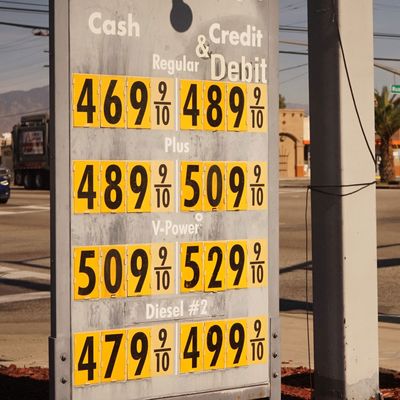
Feeling a little more broke than usual? The federal government released today its assessment of the inflation rate, officially the Consumer Price Index, and the numbers are higher than experts had predicted — and higher than at any point since 1982. Gas is up 58 percent over the last year. Beef is 21 percent pricier, too. And the cost of heating your home with fuel oil is going to cost 59 percent more than it did last holiday season. On average, prices are up 6.8 percent from a year ago, a sign that costs last month accelerated from the annual 6.2 percent spike recorded in October. Taken in isolation, it’s not a comforting trend, though rising wages and a strong job market soften the blow for many. Still, the economy is in a weird place — Wall Street thinks things are going swimmingly — as businesses around the world still deal with the pandemic.
Inflation — at least at the current levels — has long been regarded as the archenemy of a healthy economy. It sunk Jimmy Carter’s presidency and created a decade of economic turmoil in the late ’70s and early ’80s. Things haven’t gotten that bad yet, but there’s a concern that this could get out of hand. So how much longer can this go on for? President Joe Biden tried to get ahead of the numbers on Thursday, saying that things are already cooling off, largely reflecting a drop in gas prices, that won’t be reflected in the CPI until next month. Federal Reserve Chair Jerome Powell has signaled he’ll act to tighten up the flow of money in the economy faster than expected — a risky move that is designed to tame demand. That is, if there’s less money to go around, then people won’t be so willing to buy all the stuff that’s getting more expensive by the month. The downside of the strategy though is that it could also send financial markets tumbling — as happened in late 2018, before Powell backed down and turned on the money spigots again. But the reality is that much of what’s behind the rise in prices is out of any one person’s control. Think of it like the world’s largest Ouija board, with billions of hands — including U.S. consumers and Russian oil oligarchs and Asian factory workers — all pushing the planchette to a number on the board, and nobody quite knows where it’s going to land. But there are three factors that have played a particularly important role in driving up November’s inflation numbers — and probably your monthly credit-card bill.
The supply chain is still screwed up
One of the clearest ways to understand why prices are rising is to track how physical goods have been stuck in place. This is generally what’s meant when people refer to problems in the supply chain, an interconnected global web of manufacturers, ships, ports, trucks, and deliveries meant to get goods into the hands of you, the consumer. Normally, things run pretty smoothly, but wave after wave of COVID infections in places like Vietnam — the sixth-largest goods supplier for the U.S. — have pushed back manufacturing, leading to a domino effect for everything down the chain.
This summer and fall, the backlog of containers at major ports was so severe that one ship waited nearly eight weeks before it could dock and unload its cargo, according to the Wall Street Journal. Facing bare shelves and delays, stores started to raise prices on the goods they did have. The Biden administration proposed billions in funds to keep the flow of goods going, and while the delays have eased up since then, that has more to do with conditions getting better in Asia. Still, there’s reason to think that things are slowly getting back to normal. “It looks like we’re past the worst,” Paul Gruenwald, global chief economist at S&P Global Ratings, told Intelligencer. But it hasn’t been an even recovery across the country’s ports. Back in March, before prices really started to rise, it took a little under 20 hours before goods delivered into the Port Authority of New York and New Jersey would get offloaded, according to data from the agency. Now, it takes about 32 hours. “Our analysts who are looking at that sector still see another six months more or less of kind of stickiness and congestion in the supply chain,” Gruenwald added. It shows that even if one snarl in the supply chain loosens up, another problem — say, a shortage of truckers — could still weigh things down.
Energy prices spiked in November
Earlier this year, concerns about persistent inflation weren’t taken very seriously because the rise in prices was concentrated around things like rental cars — not a major, recurring cost for most people, and something that had a lot to do with the bankruptcy of Hertz during the early months of the pandemic. Now, it’s all about the spike in the price of oil and gas — the lifeblood of the economy, the way most people heat their homes and get to work. It was serious enough that the Biden administration released 50 million barrels of oil from its strategic reserves, enough to cover more than five days the country’s energy needs.
The November data, too, appears to reflect the peak of prices. Last month, a barrel of oil hit a high of $85, more than double where it was a year ago. Since then, it’s fallen to a little above $70, due to the brief panic over omicron and an increase in production from oil-producing countries. When prices are this high, shale producers in the U.S. also tend to start taking oil out of the ground, since the high prices justify the expensive work. “Prices are still highish. They’re in the low 70s. But the inflation part of that story is over. We don’t think prices are going to be going up from here,” Gruenwald said.
People are still spending their stimulus money
The last two years have seen an unprecedented $5 trillion sent directly to U.S. citizens and businesses in order to keep families from starving and businesses from closing while states ordered people to stay at home. At the same time, the Fed kept interest rates at practically zero, making it cheaper and easier than it had been in years to borrow money for things like a house or a car. Thanks to additional social programs like the child tax credit, financial cushions are more stable than ever for more people. The result? There’s more money in the system and consumers have done what they do best — buy stuff, price and supply chain be damned. “Demand across the economy recovered a lot faster than most households and businesses anticipated,” said Joel Prakken, chief U.S. economist for IHS Markit.
On the other side of the supply-and-demand equation, corporate America has also had a role in rising prices. Public companies had one of their best earnings seasons ever last quarter, boosted not only by the stimulus money that’s leaving customers’ accounts, but by the subsidies that came directly from the government for the businesses. That gave them the leeway to raise prices — even on products that weren’t facing supply-chain problems. “It does put sellers in the driver’s seat in terms of being able to raise prices without fear of losing market share,” Prakken said. While companies are preparing to use some of that money to raise workers’ pay next year, any wage gains will probably come as the Fed cools down the economy. Powell has signaled that he’s ending a massive market-stimulus program in which the central bank purchases debt. After that, the central bank is likely to start raising interest rates, making it more expensive to borrow money for a home or a car, or even just to carry a balance on a credit card. That, of course, tends to tamp down demand and cool inflation. But higher rates affect consumers to — so even if prices now are higher than normal, it might still be a good time to buy.






























